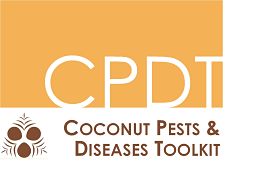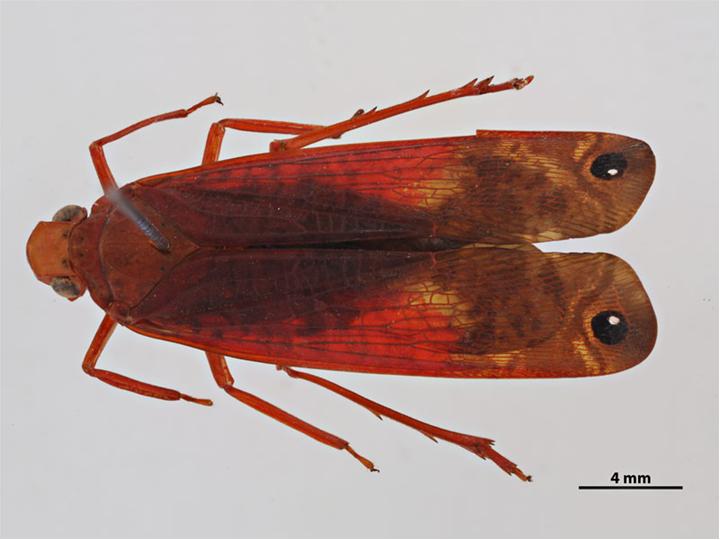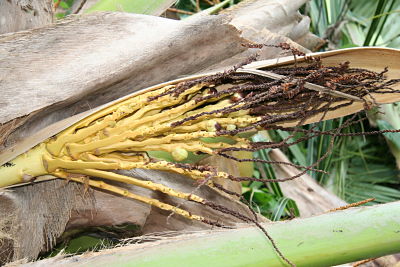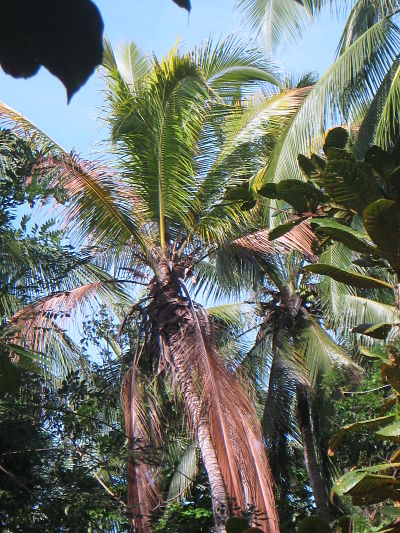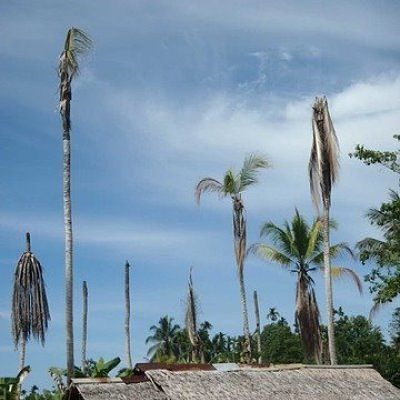Bogia coconut syndrome (BCS)
Bogia coconut syndrome (BCS) is thought to be caused by a Phytoplasma bacterium. Bogia coconut syndrome is one of the lethal yellowing diseases of coconut BCS is the only form of lethal yellowing disease currently found in the Pacific, where it has been only detected in Papua New Guinea (PNG).
Common name of the diseaseBogia coconut syndrome (BCS) |
Scientific name of the cause of the disease'Candidatus Phytoplasma noviguineense' |
on this page: Vector insects : Symptoms : Impacts : Distribution : Prevention : Controlling Bogia coconut syndrome : Information sources and further reading
Phytoplasmas are highly specialised wall-less bacteria that can survive only inside the plants that host them and the insects that spread them from plant to plant.
Phytoplasmas cannot be cultured in the laboratory and can only be studied using the tools of molecular biology (DNA analysis). Because of this they have complex grouping and naming conventions. The BCS phytoplasma is a member of a group of closely related phytoplasmas in PNG that have been placed together under the tentative species name of 'Candidatus Phytoplasma noviguineense'.
See the Symptoms section below to identify BCS on coconut palms by the symptoms of the disease.
Vector insectsInsects that can spread diseases like phytoplasmas are called vectors. The phytoplasma must be able to reproduce inside a vector insect’s body, and then move out through its mouth parts when it feeds on a new host plant. Usually this is only possible in a small number of insect species. In studies on BCS in PNG, several sap feeding insects found in the country are very strongly suspected to be vectors of the phytoplasma. One of the most important and widespread is the planthopper Zophiuma pupillata, which breeds on coconut palms. For Bogia coconut syndrome to occur, both the vector insect and the phytoplasma must be present. |
Adult Zophiuma pupillata (© Ken Walker, PaDIL) |
Symptoms
|
All ages of palms are susceptible to BCS. The symptoms of BCS have a very well-defined sequence, with five distinct stages, which happen very rapidly. It is this well-defined sequence that helps identify the disease from other possible conditions.
Rotting of flowers in the inflorescences starting at the tips. An early symptom (© Northern Australia Quarantine Strategy, Department of Agriculture and Water Resources, Australia |
Outer parts of the frond turning yellow and the older fronds turning brown and drooping (© Northern Australia Quarantine Strategy, Department of Agriculture and Water Resources, Australia) |
|
| An early symptom may also include male and female flowers in the inflorescences rotting (see image above left).
Eventually, all fronds fall, leaving only dead stems. Although each of these symptoms can be caused by other things, the sequence of symptom development, and its rapid speed, is unique to phytoplasma disease. This presentation by the Kokonas Indastri Korporesen (KIK) describes the progress of the disease well - please ensure KIK is credited for use of any material from this presentation. Death will occur after 3 months of initial symptoms. BCS is similar to lethal yellowing disease but a strong yellowing of the canopy is not common. Other crops, such as banana, can also be affected by the BCS phytoplasma and can indicate the presence of the disease in the area. |
Coconut palms with dropping fronds or spear leaf only (© Luigi Guarino, Global Crop Diversity Trust) |
Impacts
Very little is known about how this disease is spread and there are limited control methods. Therefore there have been hundreds of palm deaths and many plantations in Papua New Guinea have been abandoned.
BCS is a major concern as coconut is an important food and trade source in PNG. The loss of plantations from the disease can cause serious problems for social and economic security. Copra and coconut oil exports individually bring in around $30-45 million per year!
Stewart Research Station of the Cocoa & Coconut Research Institute, Papua New Guinea currently holds the International Coconut Genebank for the South Pacific. Spread of the disease to this area could be devastating to on-going and future coconut plantations all around the Pacific.
Distribution
The disease has only been recorded in the Madang Province of Papua New Guinea, but it is spreading within the Province. The current status of the distribution can be found in this presentation by the Kokonas Indastri Korporesen (KIK) - please ensure KIK is credited for use of any material from this presentation.
Prevention
Good biosecurity is the only way to prevent BCS from developing in new locations.
Most importantly, the International Guidelines for transfer of coconut germplasm should be strictly followed to prevent pests and diseases being moved to new locations.
The BCS phytoplasma has been found in betelnut palms and banana plants. Young plants, including banana suckers that don't show any symptoms, can carry the phytoplasma to new places. Restricting the movement of coconut, betelnut and banana planting material out of Madang Province is vital and this will slow the spread of BCS.
Although the risks posed by coconuts and betelnuts for planting are not fully understood yet, it would be safest to include these in the restrictions. Research into BCS is identifying other host plants, and as these hosts are found, they will also need to be targeted.
Bogia coconut syndrome requires the presence of both the phytoplasma and the Zophiuma insect. To prevent BCS spreading around the Pacific, Zophiuma should be treated as a high risk pest.
For general information on preventing pests and diseases of coconut, see the Prevention section.
Controlling Bogia coconut syndrome
Recommendations on controlling the disease are limited to banning the movement of live coconut tissue (sees, germplasm, pollen). If movement is necessary the FAO/IBPGR Technical Guidelines for the Safe Movement of Coconut Germplasm must be followed.
Importantly, phytoplasmas cannot be transmitted on tools used to work on affected plants, such as bush knives.
From a research perspective, it is very important to test for tolerance and resistance of different coconut varieties as this has worked for similar diseases elsewhere in the world, and would provide the best control of all. Having diverse coconut plantations may be important to limiting the effects of disease. It is also important to identify the full range of insects that can transmit the phytoplasma.
For general information on preventing pests and diseases of coconut, see the Prevention section.
Information sources and further reading
Batugal, Ramanatha, Oliver. 2005. Coconut Genetic Resources.International Plant Genetic Resources Institute – Regional Office for Asia, the Pacific and Oceania (IPGRI-APO), Serdang, Selangor DE, Malaysia.
Gurr et al. 2016. Coconut Lethal Yellowing Diseases: A Phytoplasma Threat to Palms of Global Economic and Social Significance. Frontiers in Plant Science, 7, 1521, 1-21.
Kelly et al. 2011. First report of a phytoplasma identified in coconut palms (Cocos nucifera) with lethal yellowing-like symptoms in Papua New Guinea. New Disease Reports 23:9. [ONLINE]
Lu et al. 2016. Determining putative vectors of the Bogia Coconut Syndrome phytoplasma using loop-mediated isothermal amplification of single-insect feeding media. Science Report, 6, 35801, 1-10.
Miyazaki et al. 2018. ‘Candidatus Phytoplasma noviguineense’, a novel taxon associated with Bogia coconut syndrome and banana wilt disease on the island of New Guinea. International Journal of Systematic and Evolutionary Microbiology doi: 10.1099/ijsem.0.002480. [ONLINE]
PestNet. 2017. Coconut Bogia Disease. [ONLINE]
Plant Village. 2018. Coconut; Diseases and Pests, Description, Uses, Propagation. [ONLINE]
content reviewed by Richard Davis, Northern Australia Quarantine Strategy, Department of Agriculture and Water Resources, July 2018; Sharon Woruba, Jimmy Risimeri and Eremas Tade, Kokonas Indastri Koporesen, Papua New Guinea, October 2018
